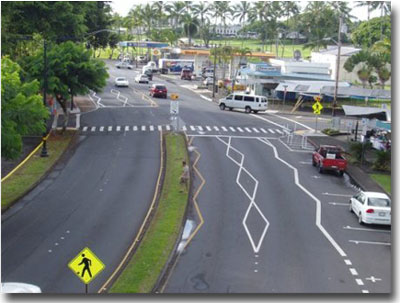Device name(s): Striping & Markings
Approximate Cost: $1.50 per linear foot ($500-$1,000 per 500-feet)
Speed Reduction: 1-7+ mph
Definition: Signage, which may include regulatory and/or warning signs, can aid in increasing drivers’ awareness of existing street conditions. Striping a roadway helps define the travel lane for motorists and sometimes provides designated bike lanes or parking lanes. Striping a roadway can also visually narrow the width of the street. Roadway markings are a relatively inexpensive method to promote traffic safety and traffic calming. Recommended markings include, but are not limited to, crosswalks, stop bars at stop signs, and traffic signals, delineated bicycle and parking lanes, cross-hatching at lane narrowing, centerlines and curb lines. Street markings are visual cues to drivers to moderate their speeds.
Fast Facts:
- Can be used on Local Street- yes
- Can be used on Collector-yes
- Can be used on Arterial- yes
- Reduces Speed- yes
- Reduces Volume- no
- Noise Impact- no
- Restricts Access- no
- Bicyclist Impact- possible
- Transit Impact- no
- Parking Impact- no
- Emergency Response Impact- no
Advantages:
- increases motorist awareness of street conditions
- can be easily modified
- low cost
- no affect on emergency vehicles
- inexpensive means to narrow travel lanes and to delineate other roadway users space
- can be used in conjunction with other measures
- passive control
Disadvantages:
- temporary reduction in speed
- increases regular maintenance
- not self-enforcing
- need to maintain (repaint or reapply in time)
- paint and striping can be hazardous to bicyclists during rainy conditions
- passive control may not be effective
